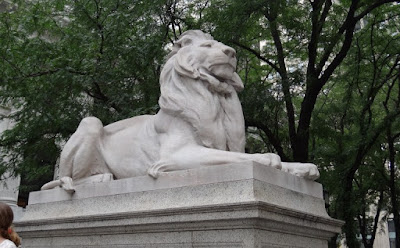Thursday, December 31, 2020
Thursday, December 24, 2020
Tuesday, December 22, 2020
Tuesday, December 15, 2020
The Lions of Fifth Avenue
Tuesday, December 8, 2020
Waste to Energy: CopenHill
What really makes this facility stand out though is the building surrounding it. Designed by Bjarke Ingels, it is an eye-catching tall facade with a slope on the side that provides recreation possibilities for all: a ski hill for varying styles and abilities, a climbing wall that is, at 260 ft or 80 metres, the tallest climbing wall in the world as well as hiking trails up the hill. People who prefer not to hike up with their skis or use the tow can ride an elevator that gives views inside to the facility and outwards to the beauty of Copenhagen harbour.
You might be wondering, how is Copenhagen, with only a few days of snow per year, able to sustain a ski hill? The skiing surface is an Italian-made material called Neveplast Artificial Snow, which provides a nearly snow-like experience for skiers and snowboarders while at the same time, trees and plants along the edges enhance the enjoyment.
Tuesday, December 1, 2020
The Giant Hand of Vrynwy
This is the Giant Tree of Vrynwy in Powys, North Wales. Unfortunately, I didn't see it on my 2018 Offa's Dyke Walk. In fact, I just learned about it when someone recently tweeted it. It caught my imagination so I had to investigate and here's what I discovered. (Covid adventures - haha)
Of course, when you see something on Twitter you tend to think it's something new, something that has happened recently, but in fact, this sculpture was completed in 2011. It's located on an estate with a reservoir where people often walk in a forest of giant redwoods called the Giants of Vyrnwy and this tree used to be the tallest of all of them.
In 2011 someone noticed some significant storm damage to the tree that caused the top part to be removed so as not to fall on any unsuspecting walkers. The search started for an artist to give new life to the tree as a sculpture and one thing after another, Simon O'Rourke, an artist living in Wales, found himself with a new project.
Scaffolding was erected, not an easy task on the uneven ground around the tree and work began. O'Rourke, inspired by earlier artists such as Rodin decided on a hand reaching for the sky as an appropriate symbol for a giant tree and began work using a chainsaw and smaller carving tools.
The completed structure is 50 ft. tall. O'Rourke modelled the hand after his own and says the experience humbled him, reminding him of "just how insignificant we humans are compared to some of the living organisms on this earth."
After 2 days to erect the scaffold and another 6 days of intense carving, with the addition of two pieces for the thumb and little finger since the tree wasn't wide enough to provide them, the work was done. Tung oil was applied and there it stands for all to see.



















